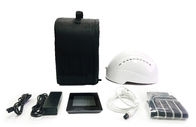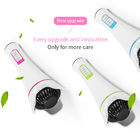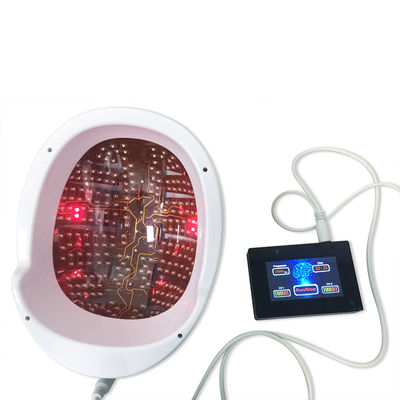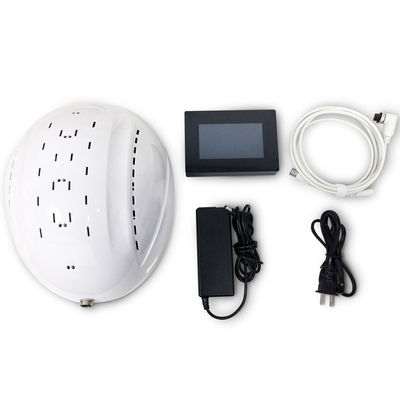FAQ of Photobiomodulation Therapy Helmet
1.How often does a person use the helmet?
For long-term chronic diseases, such as degenerative diseases, the recommended course of treatment is 3-6 months.
For short-term symptoms, such as concussion, migraine, depression, etc., the recommended course of treatment is 1-3 months. According to the severity of the patient’s symptoms, use 4-6 times a week, 1-2 times a day. At the beginning of the treatment, it is recommended to give the patient a process of adaptation. About the power intensity and time, you can start from 25% , 12 minutes. Gradually increase the power intensity and time step by step. After a adapation period, can use 75-100% intensity for 24-30 minutes.
2.How long to set the timer?
You can choose 6 minutes – 12 minutes – 18 minutes – 24 minutes – 30 minutes
3.Are your infrared LEDs near infrared?
Our model is near infrared with 810nm.
4.Why do you use a mix of red LED and infrared LED? Why are they red?
We use 256pcs near infrared light for therapy. There are 4 pcs red led for instruction, to show you the device is working.
Sometimes the near infrared is hardly to be seen from eyes, so the red light just for instruction, not for therapy function.
5.Have you found that your machine is able to actually penetrate the brain?
Yes, we have got a lot of research to prove this thoery which 810nm light can penetrate the brian.
6.How deep have you seen your machines tested to penetrate through the brain?
The 810nm light can penetrate our skull and works on nerve cell, and there is Cytochrome C Oxidase inside the Mitochondria of the
cell, to promote the cell viability.
7.What frequency?
For the button model, the frequency is 40Hz, for the touch screen model, the frequency is 1-20,000 Hz adjustable.


Introduction
Photobiomodulation (PBM) describes the use of red or near-infrared light to stimulate, heal, regenerate, and protect tissue that has either been injured, is degenerating, or else is at risk of dying. One of the organ systems of the human body that is most necessary to life, and whose optimum functioning is most worried about by humankind in general, is the brain.
The brain suffers from many different disorders that can be classified into three broad groupings: traumatic events (stroke, traumatic brain injury, and global ischemia), degenerative diseases (dementia, Alzheimer’s and Parkinson’s), and psychiatric disorders (depression, anxiety, post traumatic stress disorder). There is some evidence that all these seemingly diverse conditions can be beneficially affected by applying light to the head. There is even the possibility that PBM could be used for cognitive enhancement in normal healthy people.
In this transcranial PBM (tPBM) application, near-infrared (NIR) light is often applied to the forehead because of the better penetration (no hair, longer wavelength).
PBM therapy was developed more than 50 years ago; however, there is still no common agreement on the parameters and protocols for its clinical application. Some research teams have recommended the use of a power density of less than 100 mW/cm2 and an energy density of 4 to 10 J/cm2 [11]. Others groups recommend as much as 50 J/cm2 at the tissue surface [11]. Parameters like wavelength, energy, fluency, power, irradiance, pulse mode, treatment duration, and repetition rate can be applied in a wide range. Our present preliminary results showed a clear response of cerebral rSO2 in relation to the LED stimulation. However, it has to be mentioned that the temperature increased significantly, and these effects have to be taken into account in further studies in detail. There is also the fact that ineffective studies in cells with high mitochondrial activity appear to be due more often to over-dosing than to under-dosing [11]. Therefore, clinical studies concerning the optimal stimulation doses are necessary.
Suggest Different Frequencies for Different kinds of Diseases
| Disease |
Treatment Time |
Treatment Frequency |
| Cerebral arteriosclerosis Insufficient, blood supply to the brain |
30 minutes |
50 Hz |
| Brain atrophy |
30 minutes |
40-50 Hz |
| Alzheimer’s disease (AD) |
30 minutes |
50 Hz |
| Children with autism |
30 minutes |
10-30 Hz |
| Cerebral thrombosis, Cerebral infarction |
30 minutes |
50 Hz |
| Lacunar infarction |
30 minutes |
50 Hz |
| Recovery of traumatic brain injury after operation |
30 minutes |
30 Hz |
| The recovery period after cerebral poisoning |
30 minutes |
30-50 Hz |
| Children with cerebral palsy |
20-30 minutes |
5-15 Hz |
| Parkinson’s disease |
30 minutes |
30-50 Hz |
| Depression |
20-30 minutes |
50 Hz |
| Mental disorders |
20-30 minutes |
30-50 Hz |
| Insomnia |
20-30 minutes |
5-15 Hz |
| Nervous headache |
20-30 minutes |
20-40 Hz |
| High blood pressure |
20-30 minutes |
5-15 Hz |
| Brain fatigue disease |
20-30 minutes |
30 Hz |
| Memory loss |
20-30 minutes |
30 Hz |
| Neurasthenia |
20-30 minutes |
5-20 Hz |
| Schizophrenia |
20-30 minutes |
5-20 Hz |
Specifications
| Name |
Brain Photobiomodulation Machine |
| Model |
GY-PDT1 |
| LED Wavelength |
810 nm |
| Led Quantity |
256pcs |
| Power(total helmet) |
15 W |
| Power(one LED) |
60 mW |
| Power |
24 mW/cm2 |
| Certificate |
CE, FDA |
| OEM |
Support |
| Color |
White/Black |
| Option Time |
6-12-18-24-30 minutes |
The Brain Photobiomodulation Machine is a therapeutic instrument based on the principle of photobiomodulation. It has a good therapeutic effect on traumatic events (stroke, traumatic brain injury, and global ischemia), degenerative diseases (dementia, Alzheimer’s and Parkinson’s), and psychiatric disorders (depression, anxiety, post traumatic stress disorder)
Brain photobiomodulation (PBM) with red to near-infrared (NIR) light emitting diodes (LED) could be an innovative therapy for a variety of neurological and psychological disorders. Red/NIR light can stimulate mitochondrial respiratory chain complex IV (cytochrome c oxidase) and increase ATP (adenosintriphosphate) synthesis. In addition, light absorption by ion channels leads to the release of Ca2+ and to the activation of transcription factors and gene expression. Brain PBM therapy could improve the metabolic capacity of neurons and is able to stimulate anti-inflflammatory, anti-apoptotic and antioxidant responses as well as neurogenesis and synaptogenesis. Findings suggest that PBM may enhance, for example, the frontal brain functions of older adults in a safe and cost-effective manner.

Note the increase in the regional cerebral oxygen saturation during and after stimulation on the left and right side.

Results from thermal imaging of the first pilot measurement using the new stimulation helmet. Note the increase in temperature on the helmet (upper row; a before, b during, and c after stimulation) on the forehead (middle row; d–f) and on the chin (lower row; g–i).
Main Function
1.The 810 nm wavelength has the ability to extend through the skull to the brain, promoting recovery from traumatic brain injury and reducing long-term nerve damage.
2.810nm wavelength can help patients with severe depression and anxiety
3.NIR light is absorbed by cytochrome C oxidase in mitochondria.
4.Increased blood flow, energy, neuroprotection and less inflammation.
5.treat traumatic (stroke, TBI), neurodegenerative and psychiatric diseases.
Indications
- Traumatic events (stroke, traumatic brain injury, and global ischemia).
- Degenerative diseases (dementia, Alzheimer’s and Parkinson’s).
- Psychiatric disorders (depression, anxiety, post traumatic stress disorder).
Contraindication
- Avoid direct exposure to the eyes, pregnant woman’sabdomen, melanoma, brown spots.
- Taboo patients with early and middle stage malignant tumors.
- Contraindications to patients with acute bleeding disorders.
PBM therapy was developed more than 50 years ago; however, there is still no common agreement on the parameters and protocols for its clinical application. Some research teams have recommended the use of a power density of less than 100 mW/cm2 and an energy density of 4 to 10 J/cm2. Others groups recommend as much as 50 J/cm2 at the tissue surface. Parameters like wavelength, energy, flfluence, power, irradiance, pulse mode, treatment duration, and repetition rate can be applied in a wide range. Our present preliminary results showed a clear response of cerebral rSO2 in relation to the LED stimulation. However, it has to be mentioned that the temperature increased signifificantly, and these effects have to be taken into account in further studies in detail. There is also the fact that ineffective studies in cells with high mitochondrial activity appear to be due more often to over-dosing than to under-dosing. Therefore, clinical studies concerning the optimal stimulation doses are necessary.
Transcranial PBM appears promising to treat different mental diseases. Pitzschke et al. also measured light propagation in different areas of Parkinson’s disease (PD)-relevant deep brain tissue during transcranial and transsphenoidal illumination (at 671 and 808 nm) of a cadaver head and modeled optical parameters of human brain tissue using Monte-Carlo simulations. This study demonstrates that it is possible to also illuminate deep brain tissues transcranially and transsphenoidally. This opens therapeutic options for sufferers of PD or other cerebral diseases necessitating light therapy. There have been several investigations concerning possible adverse effects for LED PBM.
For example, Moro et al. explored the effects of longer term application, up to 12 weeks, of PBM (670 nm) in normal, naïve macaque monkeys. They found no histological basis for any major biosafety concerns associated with PBM delivered by an intracranial approach. Hennessy and Hamblin also pointed out the already established safety and notable lack of adverse effects of transcranial PBM. The preliminary results are very promising; however, further research work is required in order to be able to use, for example, this new kind of PBM as a therapeutic method. Many investigatorsbelieve that PBM with LED and/or laser for brain disorders will become one of the most important medical applications of light therapy in the coming years and decades.
Reference: Brain Photobiomodulation – Preliminary Results from Regional Cerebral Oximetry and Thermal Imaging

 Your message must be between 20-3,000 characters!
Your message must be between 20-3,000 characters! Please check your E-mail!
Please check your E-mail!  Your message must be between 20-3,000 characters!
Your message must be between 20-3,000 characters! Please check your E-mail!
Please check your E-mail!











